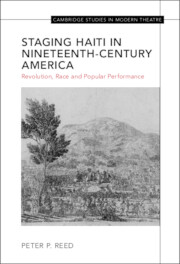65 results
Barriers to and solutions for representative inclusion across the lifespan and in life course research: The need for structural competency highlighted by the COVID-19 pandemic
-
- Journal:
- Journal of Clinical and Translational Science / Volume 7 / Issue 1 / 2023
- Published online by Cambridge University Press:
- 06 December 2022, e38
-
- Article
-
- You have access
- Open access
- HTML
- Export citation
1 - Rebels and Refugees
-
- Book:
- Staging Haiti in Nineteenth-Century America
- Published online:
- 18 November 2022
- Print publication:
- 01 December 2022, pp 33-60
-
- Chapter
- Export citation
2 - The Lessons of Haiti
-
- Book:
- Staging Haiti in Nineteenth-Century America
- Published online:
- 18 November 2022
- Print publication:
- 01 December 2022, pp 61-90
-
- Chapter
- Export citation
Index
-
- Book:
- Staging Haiti in Nineteenth-Century America
- Published online:
- 18 November 2022
- Print publication:
- 01 December 2022, pp 211-216
-
- Chapter
- Export citation
6 - Conclusion
-
- Book:
- Staging Haiti in Nineteenth-Century America
- Published online:
- 18 November 2022
- Print publication:
- 01 December 2022, pp 179-190
-
- Chapter
- Export citation
Acknowledgements
-
- Book:
- Staging Haiti in Nineteenth-Century America
- Published online:
- 18 November 2022
- Print publication:
- 01 December 2022, pp x-xii
-
- Chapter
- Export citation
Figures
-
- Book:
- Staging Haiti in Nineteenth-Century America
- Published online:
- 18 November 2022
- Print publication:
- 01 December 2022, pp ix-ix
-
- Chapter
- Export citation
Contents
-
- Book:
- Staging Haiti in Nineteenth-Century America
- Published online:
- 18 November 2022
- Print publication:
- 01 December 2022, pp vii-viii
-
- Chapter
- Export citation
5 - Abolitionist Acts
-
- Book:
- Staging Haiti in Nineteenth-Century America
- Published online:
- 18 November 2022
- Print publication:
- 01 December 2022, pp 150-178
-
- Chapter
- Export citation
4 - Travesty and Transformation
-
- Book:
- Staging Haiti in Nineteenth-Century America
- Published online:
- 18 November 2022
- Print publication:
- 01 December 2022, pp 120-149
-
- Chapter
- Export citation
Introduction
-
- Book:
- Staging Haiti in Nineteenth-Century America
- Published online:
- 18 November 2022
- Print publication:
- 01 December 2022, pp 1-32
-
- Chapter
- Export citation
Bibliography
-
- Book:
- Staging Haiti in Nineteenth-Century America
- Published online:
- 18 November 2022
- Print publication:
- 01 December 2022, pp 191-210
-
- Chapter
- Export citation
Copyright page
-
- Book:
- Staging Haiti in Nineteenth-Century America
- Published online:
- 18 November 2022
- Print publication:
- 01 December 2022, pp vi-vi
-
- Chapter
- Export citation
3 - Virtuosity, Illegitimacy, and Haitian Royalty
-
- Book:
- Staging Haiti in Nineteenth-Century America
- Published online:
- 18 November 2022
- Print publication:
- 01 December 2022, pp 91-119
-
- Chapter
- Export citation

Staging Haiti in Nineteenth-Century America
- Revolution, Race and Popular Performance
-
- Published online:
- 18 November 2022
- Print publication:
- 01 December 2022
Vertical mobility and cotton tolerance to trifludimoxazin, a new protoporphyrinogen oxidase-inhibiting herbicide, in three West Texas soils
-
- Journal:
- Weed Technology / Volume 35 / Issue 1 / February 2021
- Published online by Cambridge University Press:
- 25 August 2020, pp. 144-148
-
- Article
-
- You have access
- Open access
- HTML
- Export citation
Filling in the Missing Wedge with Aberration-corrected Electron Tomography
-
- Journal:
- Microscopy and Microanalysis / Volume 26 / Issue S2 / August 2020
- Published online by Cambridge University Press:
- 30 July 2020, pp. 924-925
- Print publication:
- August 2020
-
- Article
-
- You have access
- Export citation
Achieving High-resolution of Large Specimens Using Aberration-corrected Tomography
-
- Journal:
- Microscopy and Microanalysis / Volume 26 / Issue S2 / August 2020
- Published online by Cambridge University Press:
- 30 July 2020, pp. 1860-1862
- Print publication:
- August 2020
-
- Article
-
- You have access
- Export citation
Carin Berkowitz and Bernard Lightman (eds.), Science Museums in Transition: Cultures of Display in Nineteenth-Century Britain and America. Pittsburgh, PA: University of Pittsburgh Press, 2017. Pp. xi + 375. ISBN 978-0-8229-4475-1. $45.00 (hardcover).
-
- Journal:
- The British Journal for the History of Science / Volume 52 / Issue 1 / March 2019
- Published online by Cambridge University Press:
- 05 March 2019, pp. 168-170
- Print publication:
- March 2019
-
- Article
- Export citation
Persistence and Movement of Fomesafen in Florida Strawberry Production
-
- Journal:
- Weed Science / Volume 66 / Issue 6 / November 2018
- Published online by Cambridge University Press:
- 02 October 2018, pp. 773-779
-
- Article
- Export citation



